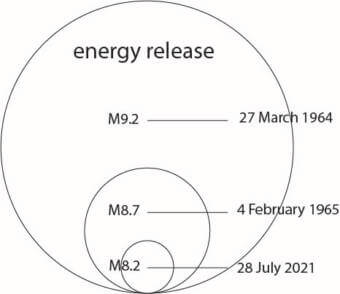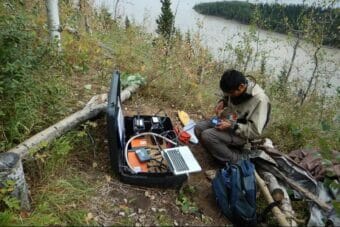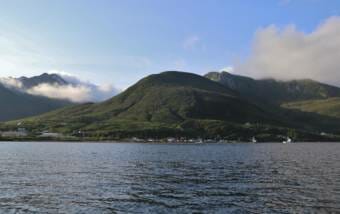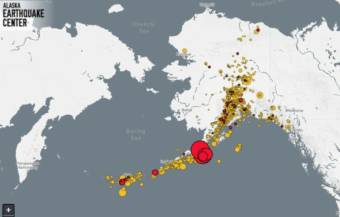
The magnitude 8.2 earthquake that struck off Alaska’s southwest coast Wednesday night gave nearby residents a good shake and triggered tsunami warnings, but there were no large waves or any immediate reports of major damage or injuries.
Still, it was the largest earthquake in the United States in more than 50 years, a classic Alaska subduction zone earthquake, where the tectonic plate beneath the Pacific Ocean is subducting — sliding under — the North American plate upon which Alaska sits.
Seismologist Stephen Holtkamp with the Alaska Earthquake Center is one of the researchers studying Wednesday night’s quake.
Holtkamp told Alaska Public Media’s Casey Grove that it caused little apparent damage because of it remoteness and depth.
Listen here:
The following transcript was lightly edited for clarity.
Stephen Holtkamp: There are a couple of factors here. First, the Aleutians are very sparsely populated. The nearby towns that received heavy shaking in places like Perryville only have 100 or so people living in them. So it’s fairly sparsely populated.
But maybe more importantly is the depth of the earthquake, how deep it is in the earth. This earthquake occurred at a depth of about 32 kilometers, which is a good deal down in the earth, meaning that even if you were standing directly on top of where the earthquake was happening, you’re still 30 kilometers away from it.
Contrast that with something like Southern California where you can have very significant human impacts from significantly smaller events, because those faults rupture the surface. So, if you’re on top of where the epicenter is in California, you are zero kilometers away from where the earthquake is shaking. And that translates into much more potential for damage, much higher amounts of shaking.
Casey Grove: The earthquake didn’t seem to produce a very large wave. Is that related to the depth as well?
Stephen Holtkamp: Yes, exactly. When a subduction zone earthquake happens, there’s a significant amount of vertical deformation of the sea floor. So the sea floor basically gets pushed up during the earthquake. That pushes the water level up, and then that water collapses and produces a tsunami.
Because this was so deep in the earth though, that vertical surface deformation was much less. So if this event were shallower — and there are magnitude 8 events that can occur shallower — we would have expected a much larger tsunami.
This is one of the difficulties that agencies like the Tsunami Warning Center have to deal with. From the time of the earthquake to when the first tsunami waves arrive in nearby towns can be on the order of 10 to 20 minutes. That’s pretty close to the amount of time that it takes us to even start to get to good locations.
So if we waited until that accurate determination would have happened, then if there were a tsunami, it would have already swept through the the coastal towns nearby the earthquake. So they they really err on the side of caution. We’re going to go ahead and get the warning out. And then as the data roll in, we’ll get better and better constraints on exactly where the earthquake happened, and adjust the tsunami warning at that point.
Casey Grove: Yeah, I guess, better safe than sorry, right? So let’s maybe zoom out a little bit. Tell me more about the region where this quake occurred, and research that’s gone on long-term there.
Stephen Holtkamp: Yeah, so this is occurring in an area known as the Shumagin Gap that has not had a significant earthquake in the past at least 100 years. And these are places that seismologists or scientists focus on particularly carefully, because if there hasn’t been an earthquake for a long time, it might be more possible for an earthquake to occur there in the near future.
So it’s an area that has had lots of scientific attention paid to it. There have been seismic and geodetic deployments aimed at trying to identify exactly how much the faults are coupled in this region.
So it’s exciting to see that at least play out, from a scientific perspective. We’re just glad that injuries and loss of life and property seems to have been minimized, while we can still learn something important about the earth and protect against future damages.

Casey Grove: Yeah, I wanted to ask you about that: Am I understanding correctly that this maybe relieves some kind of pressure toward a larger earthquake that could even be more damaging? Maybe?
Stephen Holtkamp: Yes, every earthquake does relieve pressure. But there’s a few things at play here. First, whenever an earthquake happens, it actually increases the pressure, if you will, on adjacent areas of the zone. So at this point, it is at least slightly more likely that an earthquake will occur adjacent to where this earthquake just occurred.
The other thing to recognize: The sizes of earthquakes are not linear, right? A magnitude-9 is significantly larger than a magnitude-8. Thirty-three times larger, in fact, in terms of energy. So it would take 33 magnitude-8s to make up for a magnitude-9. So the math doesn’t really quite work out so well, in terms of thinking that this earthquake will relieve the pressure of a magnitude-9. It doesn’t even come close to that. So there’s still the potential of large earthquakes occurring at any time along the subduction zone.



